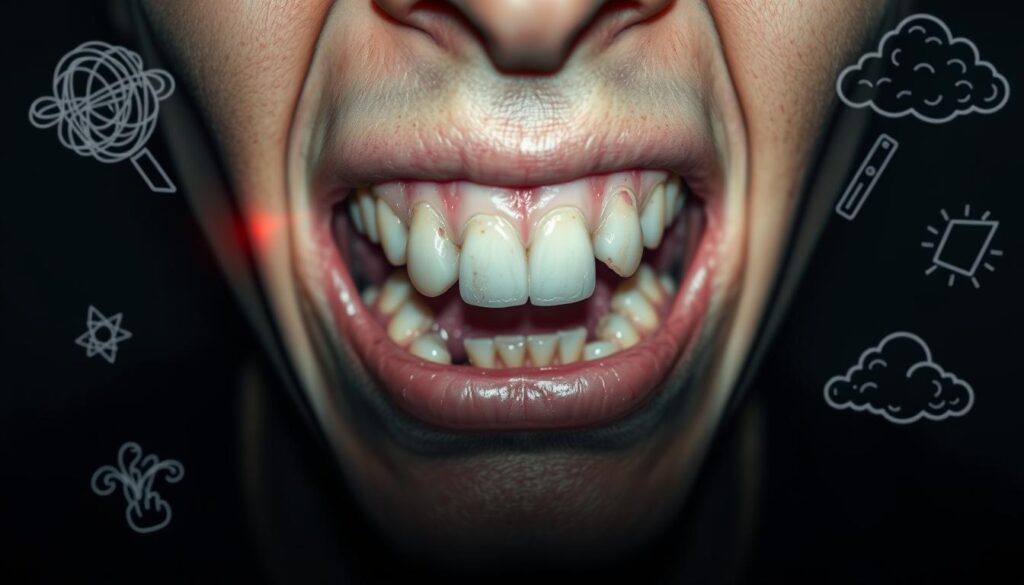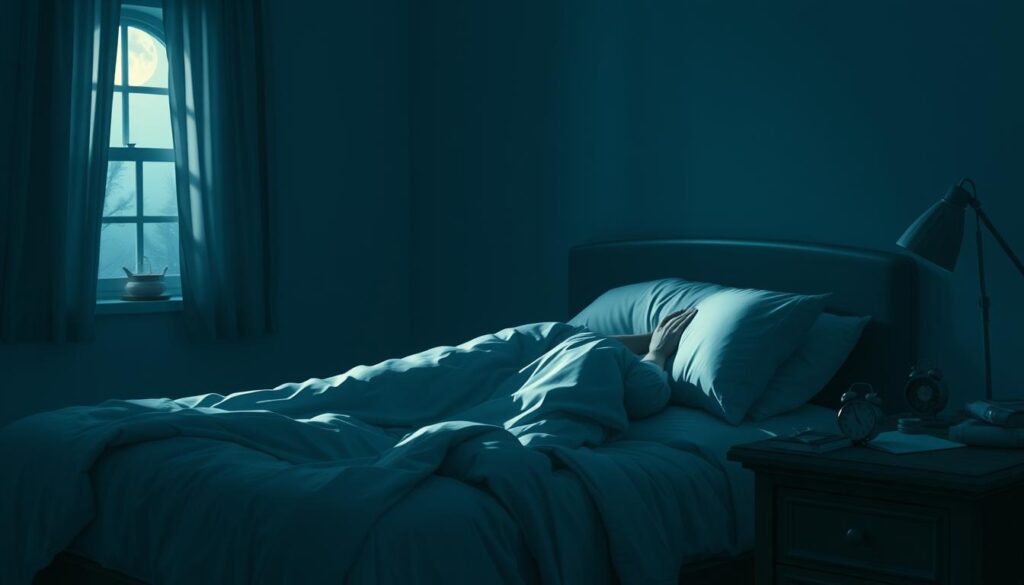Did you know that up to 31% of the global population grinds or clenches their teeth involuntarily? This common issue can harm your dental health. It leads to uncomfortable symptoms and serious problems if not treated.
In this detailed article, we’ll explore the causes, symptoms, and treatments for bruxism. We aim to give you the tools to manage this dental challenge effectively.

Key Takeaways
- Bruxism is the involuntary grinding or clenching of teeth, affecting up to 31% of the global population.
- Bruxism can lead to a range of uncomfortable symptoms, including jaw pain, headaches, and tooth damage.
- Identifying the underlying causes, such as stress or sleep disorders, is crucial for effective treatment.
- A combination of lifestyle changes, dental interventions, and medical treatments can help manage bruxism and its associated symptoms.
- Seeking professional diagnosis and guidance is essential for developing a personalized treatment plan.
Understanding Bruxism: An Overview
Bruxism is when you involuntarily grind or clench your teeth. It has two types: sleep bruxism and awake bruxism. Sleep bruxism happens when you’re asleep and can disrupt your sleep. Awake bruxism occurs when you’re awake, often as a stress response or habit.
Types of Bruxism
Sleep bruxism is more common and can harm your teeth and jaw. It’s linked to poor sleep quality. Awake bruxism, caused by stress or habit, can lead to TMJ disorders and other jaw problems.
Who is Most Affected by Bruxism
Bruxism can hit anyone, but it’s common in young and middle-aged adults. Sleep disorders, stress, and some medications raise your risk. People with certain genes or medical conditions like Parkinson’s are also at higher risk.
Impact on Dental Health
Bruxism can seriously harm your teeth. It can wear them down, making them shorter and more sensitive. It can also damage dental work, leading to costly repairs.
| Dental Impacts of Bruxism | Potential Consequences |
|---|---|
| Tooth Wear | Shortened, flatter, and more sensitive teeth |
| Dental Restoration Damage | Broken or worn down fillings, crowns, and other dental work |
| Temporomandibular Joint (TMJ) Issues | Jaw pain, stiffness, and potential development of TMJ disorders |
“Bruxism can have a significant impact on dental health, leading to tooth wear, dental restoration damage, and even temporomandibular joint issues.”
Common Causes and Risk Factors
Bruxism is when people grind or clench their teeth. It’s caused by many things. Knowing what causes it helps us manage and prevent it.
Stress is a big reason for bruxism. Feeling anxious or tense can make people clench their teeth, especially at night. This can hurt their teeth and overall health.
Sleep disorders also lead to bruxism. Problems like sleep apnea or insomnia can make people grind their teeth. These issues mess up sleep and cause teeth grinding.
Occlusal factors, like a bad bite, can also cause bruxism. Occlusal factors include misaligned teeth or TMJ disorders. These can make people grind their teeth more.
| Common Causes of Bruxism | Risk Factors |
|---|---|
| Stress Sleep disorders Occlusal factors | Anxiety and depression Caffeine and alcohol consumption Certain medications Genetics and family history |
Other things can also lead to bruxism. These include anxiety, too much caffeine or alcohol, some medicines, and genetics. Knowing these can help us stop teeth grinding.

Understanding bruxism’s causes and risks helps us fight it. Healthcare experts and people can work together to protect teeth, sleep, and overall health.
Recognizing the Signs and Symptoms
Bruxism is when you clench or grind your teeth a lot. It can cause physical and mental symptoms. Knowing these signs is key to getting help early and avoiding bigger problems.
Physical Symptoms
Jaw pain is a common sign of bruxism. People with it might feel their jaw muscles ache, especially in the morning or during the day. They might also get headaches that feel like tension or migraines.
Tooth sensitivity is another sign. Grinding and clenching can wear down tooth enamel. This makes teeth hurt when you eat or drink something cold or sweet.
Psychological Manifestations
Bruxism often comes with stress and anxiety. People with it might seem restless, irritable, or have trouble relaxing. The stress can also mess with their sleep, making it hard to fall or stay asleep.
Related Health Conditions
Bruxism can lead to other health issues. It’s often tied to TMJ disorders, causing jaw pain and sounds. It can also damage teeth, gums, and even lead to tooth loss if not treated.
Knowing the physical, mental, and health symptoms of bruxism helps you act fast. Early treatment is key to managing the condition and avoiding serious problems.
The Connection Between Stress and Teeth Grinding
Stress and anxiety can make us grind our teeth. When we’re stressed, our body might show it in physical ways. This includes grinding and clenching our teeth.
Stress and teeth grinding are closely linked. High stress can make our jaw muscles tight. This leads to grinding and clenching, often when we’re asleep. People with anxiety are more likely to grind their teeth due to stress.
“Stress is a significant contributor to bruxism, as it triggers the body’s fight-or-flight response, leading to increased muscle tension and unconscious teeth grinding.”
Managing stress is key to stopping teeth grinding. Relaxation techniques like meditation and deep breathing can help. Yoga is also good. Finding ways to deal with anxiety can also help a lot.

Knowing how stress affects our teeth can help us take action. We can reduce grinding and improve our dental health. This is good for our overall health and happiness.
Diagnosis Methods and Professional Assessment
Getting a correct bruxism diagnosis is key to finding the right treatment. Doctors use many ways to check for bruxism. These include looking at the teeth and jaws, sleep studies, and TMJ checks.
Clinical Examination Process
Dentists and healthcare experts will check the teeth, jaws, and muscles during an exam. They look for signs of grinding or clenching. They also check for tooth wear, muscle tenderness, and other symptoms.
Diagnostic Tools and Technologies
Doctors also use advanced tools to learn more about bruxism. Sleep studies monitor the patient’s sleep and muscle activity. MRI or CT scans help check the TMJ and surrounding areas.
Working with Healthcare Providers
Getting a bruxism diagnosis often means working with a team. This team includes dentists, sleep specialists, and physical therapists. Together, they can give a full assessment and create a treatment plan that fits the patient’s needs.
| Diagnostic Method | Purpose | Key Findings |
|---|---|---|
| Dental Examination | Assess tooth wear, muscle tenderness, and other physical signs of bruxism | Worn or damaged teeth, muscle pain, jaw clicking or popping |
| Sleep Study | Monitor sleep patterns and muscle activity during the night | Increased muscle activity during sleep, teeth grinding episodes |
| TMJ Assessment | Evaluate the function and health of the temporomandibular joint | Jaw joint pain, limited range of motion, clicking or popping sounds |
“Proper diagnosis is essential for effective treatment of bruxism. By working closely with healthcare providers, patients can receive a comprehensive assessment and develop a personalized plan to manage their condition.”
Treatment Options and Management Strategies
Bruxism, or teeth grinding, needs a full approach. This includes different treatments and ways to manage it. Occlusal splints, night guards, and Botox injections are key solutions.
Occlusal Splints and Night Guards
Occlusal splints and night guards protect teeth from bruxism damage. They fit over the teeth, stopping grinding or clenching. These devices also help align the jaw, easing TMJ strain.
Botox Injections
Botox injections are another option for bruxism. It’s a neuromodulator that relaxes muscles, reducing grinding. Though it offers temporary relief, it needs regular use to stay effective.
Choosing a treatment depends on the person’s needs and bruxism severity. A healthcare provider’s advice is key to finding the right solution.
| Treatment Option | Description | Benefits | Drawbacks |
|---|---|---|---|
| Occlusal Splints | Custom-made dental devices that fit over the teeth | Protect teeth from grinding Reduce TMJ strain Improve sleep quality | Require regular adjustments Can be bulky and uncomfortable initially |
| Night Guards | Removable dental devices worn during sleep | Prevent tooth-to-tooth contact Reduce wear and tear on teeth Improve sleep quality | Can be uncomfortable to wear May cause increased saliva production |
| Botox Injections | Injections of Botulinum toxin into the affected muscles | Temporarily reduces muscle contractions Provides relief from bruxism symptoms Requires no dental appliances | Effects are temporary, requiring periodic re-administration Can be expensive Potential for side effects, such as muscle weakness |
Bruxism treatment should match the individual’s needs and preferences. Exploring these options helps find the right plan with healthcare providers.
Preventive Measures and Lifestyle Changes
Dealing with bruxism needs a mix of approaches. Preventive steps and lifestyle changes are key. By tackling the causes of teeth grinding, people can manage this issue better. This helps improve their dental health.
Stress Management Techniques
Stress is a big reason for bruxism. Handling stress well can lessen symptoms. Using deep breathing exercises, meditation, and yoga can help. These methods reduce tension and calm the mind.
Regular exercise, like walking, swimming, or cycling, also helps. It manages stress and boosts well-being.
Sleep Hygiene Improvements
Good sleep is vital for bruxism control. A regular sleep schedule and avoiding caffeine and screen time before bed are key. A comfy sleep space also matters.
Adding relaxation methods, like progressive muscle relaxation or guided imagery, can help sleep better.
Dietary Considerations
What we eat can affect bruxism. Cutting down on caffeine helps because it can make teeth grinding worse. Eating a diet full of whole foods, fruits, and vegetables supports dental and muscle health.
By making these changes, people can better manage bruxism. This improves their overall health and well-being.
Long-term Effects of Untreated Bruxism
Bruxism is when you grind or clench your teeth without meaning to. It can cause serious problems if not treated. Issues like tooth damage, jaw disorders, and chronic pain can affect your health and life quality.
Untreated bruxism often leads to tooth damage. Grinding and clenching can wear down your teeth. This can make your teeth sensitive, crack, or even fall out. It also makes your teeth look bad and can lead to more dental problems.
Bruxism can also cause jaw disorders like TMJ dysfunction. This puts strain on your jaw muscles and joints. It can cause pain, stiffness, and even make it hard to open your mouth or chew. These issues can make chronic pain worse and affect your daily life.
Bruxism can also lead to chronic headaches and migraines. The muscle tension can spread to your head and neck. This can make you less productive, miss work more, and lower your quality of life.
It’s important to get help for bruxism early. Treating it can prevent these problems and keep your teeth and body healthy.
“Ignoring the symptoms of bruxism can lead to a domino effect of dental and health issues, making it crucial to address the problem proactively.”
Conclusion
Bruxism is a common dental issue that affects health and well-being. Knowing its causes, symptoms, and treatments helps people take action. Getting professional help is key, as experts can offer tailored advice.
This article covered bruxism types, causes, and symptoms. It also showed how stress can lead to teeth grinding. Stress management is a big part of treating bruxism.
Early detection and management of bruxism are vital. They prevent serious problems like tooth damage and jaw pain. By taking preventive steps and working with dental experts, people can manage their dental health and feel better overall.
FAQ
Q: What is bruxism?
A: Bruxism is when you grind, clench, or gnash your teeth without realizing it. It often happens when you’re sleeping or feeling stressed.
Q: What are the common symptoms of bruxism?
A: Signs of bruxism include jaw pain, headaches, and sensitive teeth. You might also notice wear on your tooth enamel.
Q: Who is most affected by bruxism?
A: Anyone can get bruxism, but it’s more common in kids, young adults, and those under a lot of stress or anxiety.
Q: What are the main causes of bruxism?
A: Stress, sleep problems, a misaligned bite, and some medications or health issues can cause bruxism.
Q: How can bruxism be diagnosed?
A: A dentist or healthcare provider will usually diagnose bruxism through an exam. They might use dental impressions or sleep studies.
Q: What are the treatment options for bruxism?
A: Treatments include wearing occlusal splints or night guards, Botox injections, managing stress, and sometimes dental work for bite issues.
Q: How can bruxism be prevented?
A: To prevent bruxism, manage stress, get better sleep, and avoid caffeine and alcohol.
Q: What are the potential long-term effects of untreated bruxism?
A: If bruxism isn’t treated, it can cause serious problems. These include damaged teeth, TMJ disorders, and chronic pain in the jaw, face, and neck.
